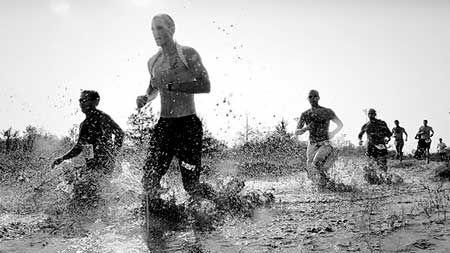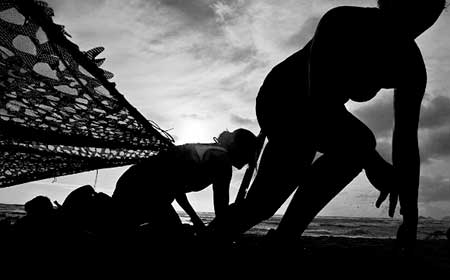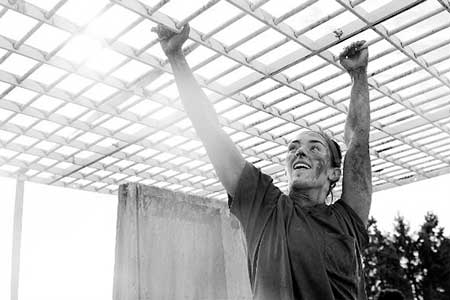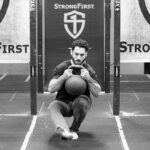Most obstacle course racers are obstacle course enthusiasts, not strength enthusiasts. To the obstacle course racing (OCR) athlete, training in the gym may be as exciting as watching paint dry. As horrifying as that sounds to an SFG, we need to have a training plan that not only makes sense for the goals of our OCR athletes, but that they can actually tolerate doing.
When working with racers, we need to be aware of some fundamental facts about them:
- They aren’t normal. They seem to enjoy suffering and will bring this mentality with them into the gym. Most obstacle course racers are members of a club or training community, so this is a huge social connection you need to be aware of. Even when training with us, they will still be doing team training three or more times per week whether you tell them it is sensible or not. This is a part of their life, so don’t expect them to change because you say it’s not “optimal.”
- They don’t care how much they can deadlift or clean and jerk. What they do care about is how fast they can finish the race, how many obstacles they had to do thirty burpees for (the typical OCR punishment for failure to clear an obstacle), and whether they needed any help to clear an obstacle.
Keep these two things in mind when you are working with these athletes. When we plan for them, we need to meet them where they are.

The Missing Link(s) for the OCR Athlete
In the 2015 World’s Toughest Mudder, the number one post-event realization on the racing forums was that the majority of racers had neglected strength training, specifically grip and carry strength. Most racers are cardio-beasts held together with iron will who don’t understand strength training or care about the need for rest and restorative strategies. It is our job as coaches to educate them so they understand these concepts and will do what we ask of them. This is much harder than teaching them to swing or do get-ups.
The biggest win for you will be to address their running, as they tend to do too much running on a poor movement foundation. This saps their recuperative ability and makes increasing strength and/or power an uphill battle. By improving movement and cutting miles, we can improve their running performance by increasing efficiency, but it also frees up more of their recuperative ability to be used in increasing strength and power. Bear in mind that to tell an obstacle course racer to cut running is tantamount to sacrilege! So be ready with your knowledge bombs to back up your decisions.
The next big bang is groundwork. This is a skill they need for the actual race, crawling is often required to overcome an obstacle. So why not become good at it? Rolling and tumbling are great for bullet-proofing the body. It is never a matter of “will I fall?” in an obstacle course race; it is a matter of “when I fall, will I be able to get back up?”

Which brings us to the value in kettlebell and bodyweight training for obstacle course racers. With a small collection of kettlebells, something to do pullups from, and perhaps a slam ball, we are well placed to perform many of the exercises that I have seen be game changers for my racers. My personal preference would be to also have access to a barbell, but if we want to capitalize on the racers’ sense of community, we can forego the barbell and do the training below as an outdoor group activity and therefore increase the level of student compliance. (This is a fancy way to say that because their friends are doing it, so will they.)
We must bear in mind that racers are some of the most “exercise ADD” people I have had the honor to work with. This means we need to give them variety to keep their attention. While we at StrongFirst abhor cookie-cutter programming and variety for the sake of it, here are some of the big bang exercises that can make a big difference to our obstacle course racing clients:
- Double Kettlebell Push Press (this truly is one of the ninja secrets for obstacle course racers)
- Rolling (including get-ups)
- Heavy Kettlebell Swings
- Goblet Squats (as patterning)
- Loaded Carries (with kettlebells, sandbags, trap bar, etc.)
- Crawling
- Pullups/TRX rows/Bat Wings
- Slam Ball
- Hanging and the Hollow Position
- Heavy Abs/Core Work
Using a circuit training method allows us to keep interest and improve recoverability, while also introducing elements of specificity, compound effect, and work capacity.
The Down & Dirty OCR Strength Training Program
Remember that the client, if part of a racing club or community, will likely have three days a week of running and club practice. Therefore, we are looking at training them twice a week. Below is a template for creating a gym or outdoor based OCR strength training program for our racer:
1. Warm-Up
This should be comprised of specific movement preparation and correctives. I like to perform FMS assessments on all my clients and use the appropriate Ground Force Method material to address any individual issues.
2. Skills and Strength
If a client cannot yet perform pullups or a specific exercise, we practice it at the beginning of the training session. It is important when learning a new skill to be fresh, which is why we do this near the beginning of our session.
We follow this with any single exercise we wish to use predominately in a strength modality. This is where we look to address the biggest strength gap the client has. Based on my past experience, these would normally be variations or progressions of pullups, pushups, barbell squats, or barbell deadlifts.
If performing the circuit outdoors and barbells or other pieces of equipment are not available, there is always an answer. Note that this element is entitled “skills and strength.” “Strength skills” such as single-leg deadlifts (single or double kettlebell), double heavy kettlebell cleans, pistol squats (loaded or bodyweight), and double kettlebell bottom-up squats can all fill this barbell-shaped hole.

3. Circuit Training
Keep the circuit short, 3 to 5 rounds of 5 to 6 exercises. Keep the reps in the 5-8 range for most drills. Rest between exercises can be from 10 to 30 seconds and between circuits rest should be 3 to 5 minutes. Program your exercises in the following order:
- Power-dominant
- Strength-dominant
- Work capacity-dominant
- Power endurance-dominant
Note: The order of the latter two can be switched as required depending on the exercises chosen.
Due to compounding fatigue, we aim to keep circuit training exercises “safe.” This means that an exercise must be of low technical demand or that the client has a large degree of competence in the execution of the exercise. Technical demand of the exercises ideally drops throughout the order of the circuit. Any overhead work (presses, push presses, snatches, or jerks) should be done early in the circuit.
Example:
- Double kettlebell push press—power-dominant/overhead
- Heavy kettlebell swings—power-dominant
- Pull up variant—strength-dominant
- Goblet squat—as an active recovery/movement drill
- Loaded carry—work capacity-dominant/safe strength
- Power ball slam—power endurance/safe power (low weight of 3-10kg as appropriate)
During the rest period, have your athlete practice diaphragmatic breathing. Help your client to own their breathing so they can speed up their recoverability.
Thanks to Pete Mardsen, former SFG II, for shooting the circuit training footage.
4. Heavy Abs
If heavy abs have been identified as a capability gap and are not used inside of the circuit, then here is the place to put them. After a sufficient rest, we perform a low-skill exercise such as:
- SFG/SFB plank variations
- Kneeling ab wheel or hanging leg raise regressions
- Four-point crawls or four-point bird dog
We must respect fatigue and our limitations, so we should aim to never let our client fail a repetition here. That is not permission to be a sissy, though—you have been warned!
5. Restorative and Flexibility
Now is the time to work on flexibility. This often overlooked quality is very important in obstacle course racing. A racer must be flexible enough to get their first leg over a high wall—once that first leg it over, the rest of them will get over! The easier we can make that first leg means a better time and more energy left for subsequent obstacles.
In practice, we carry out the following (taken from Jon Engum, StrongFirst Certified Master Instructor):
- Superset 1: Kettlebell armbar and Brettzel
- Superset 2: Frog sequence and pump (finishing with a glute stretch)
- Any specific work the individual requires
Watch this video from Louka Kurcer, StrongFirst Certified Team Leader, Elite Instructor, to understand the frog sequence:
How to Apply the OCR Strength Training Program
The week should be structured in such a way that the circuit training days are separated by two to three days and that any high demand sports/running days are to be placed on the days following a circuit day (if especially brutal sports days are known in advance, then the preceding circuit day should be of a medium intensity). We should have at least two days a week where the client is either actively recovering or completely resting.
This OCR strength training template has developed over the past five years and is something I’m confident your OCR clients can comply with. There is a lot of scope for variety and personal preference, which can be key for securing consistency in adherence to the program. It also allows for the client to be consulted on program design and add an element of ownership.
The “best plan” is one that can be followed.






Great read! I’ve been training like this for a while now and am addicted to OCR! I’ve been doing simple and sinister for about 2 years off and on and then incorporating the goblet squats and pull ups is on point! I have just started the double push press into the workouts and can see a huge difference. Now, if I could just get that running thing down…..
Excellent article. Where can I purchase a pull-up bar just like the one in the video? What’s the brand? I have been looking for a strong portable pull-up bar for my clients that is tough and tall enough and the one in the video looks perfect! Thanks
Not sure about the one in the video, Thomas, but try the T.A.P.S. bar for something stable and heavy-duty.
Great assessment of the psyche of the OCR…
You might consider changing the name of this product, due to it being very close to the name of a book that was already published from people in the OCR community.
https://www.amazon.com/Down-Dirty-Essential-Training-Obstacle/dp/1592335993
Great article, there were topics about this on the forum 🙂 very cool approach. Do you help your clients with running also sometimes ?
Thanks 🙂 Sometimes, yes. It really depends on the student and what we identify their weak point/capability gap to be.
With good level OCR athletes, for running we really need to break it into three elements in training: Long Slow Distance (own the race distance without obstacles), sub-max interval runs (what really happens in OCR) and sprint training (specific obstacle training, breaking from the pack, etc).
That alone is worthy of an article! Balancing the two aspects is where the headaches begin 😉